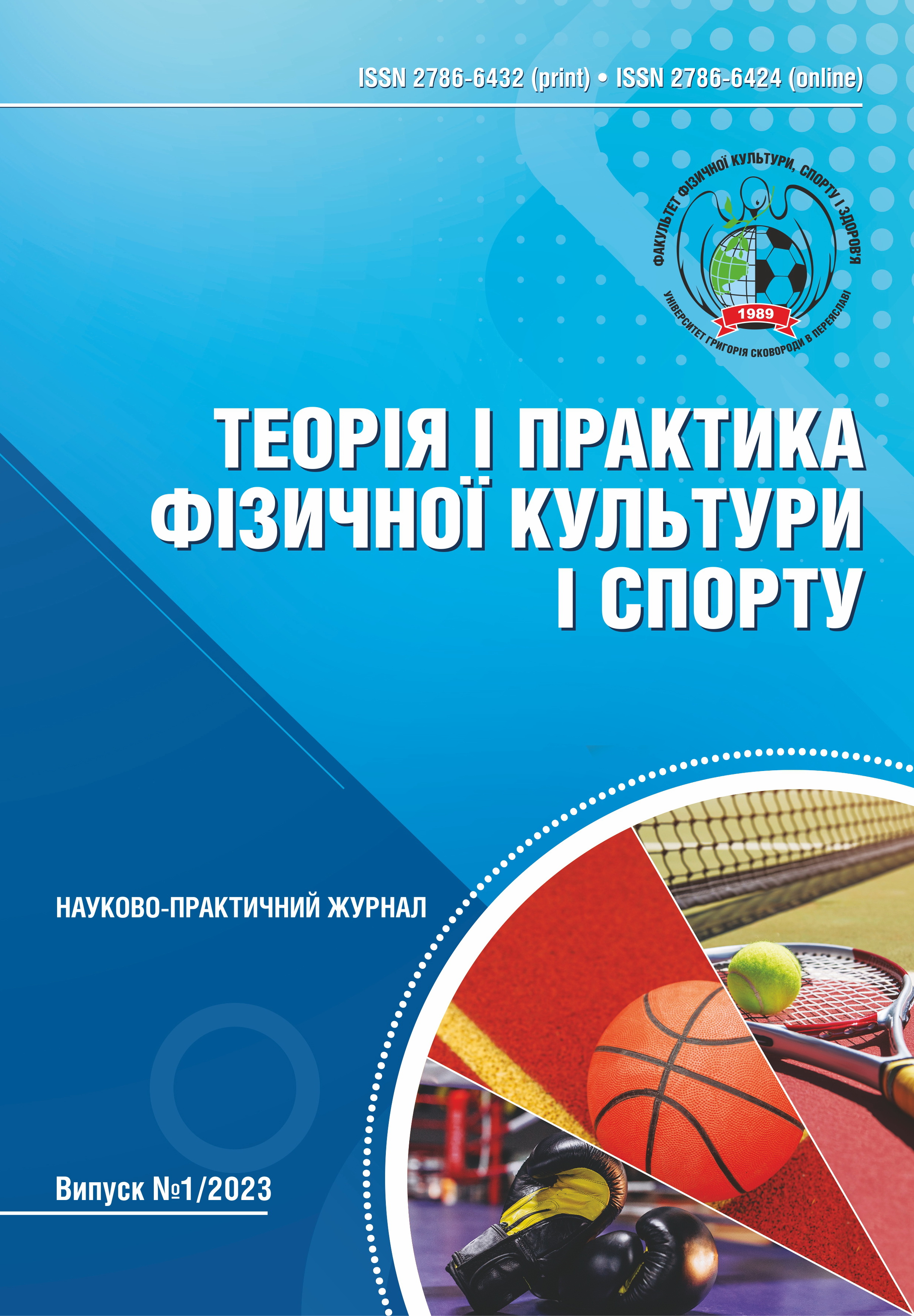SCHOOL SPORTS FACILITIES AND THEIR COOPERATIVE USE IN THE SYSTEM OF PHYSICAL CULTURE AND HEALTH ACTIVITIES.
DOI:
https://doi.org/10.31470/2786-6424-1/2023-173-177Keywords:
sports facilities, cooperation, physical activityAbstract
Annotation.
Introduction. The article examines the place of school sports facilities in the general network of physical culture and sports institutions and proposes the concept of their cooperative use in the system of physical culture and health activities in the social, household and industrial spheres.
Goal. to find out the place of school sports facilities in the general infrastructure of physical education activities and to determine the expediency and effectiveness of their cooperative use.
Methods. Analysis and generalization of scientific and methodical literature; analysis of regulatory and program-methodical documents in the field of physical culture and sports.
The results. Research confirms the need to change the structures of physical activity and, accordingly, the nature of the infrastructure that serves it. The unified system of physical activity «children's sports» - urban sports (club and mass) - sports of higher achievements fully corresponds in content to the system of physical recreation (or physical culture and health activities) - mass sports - sports of higher achievements. Physical education ceases to exist as an independent form of physical culture activity, and physical culture and sports work in schools is responsible for the content of the general category of physical culture and health activities (or in other words, physical recreation, «children's sports». The only character of physical culture activity is both educational and social , the production sphere speaks of uniform requirements for ensuring this activity, and, therefore, about the possibility of joint use of one building in different spheres (cooperation).
Conclusions. Cooperation aims to achieve efficiency in the functioning of the network of physical culture and sports facilities and the functional efficiency of the use of school sports facilities. The development of this network requires the organic inclusion of school sports facilities, which will contribute to reducing the costs of new construction and solving the problem of extensive allocation of new land plots. Modernization of existing sports facilities will significantly shorten the development time of modern sports and sports time network.
References
Bohula P.O. Scientific and methodological foundations of physical culture and sports management in Ukraine. Kharkiv. 2011. P. 192 – 193.
Borek Z. Polish experience of health and recreation activities using sports facilities of the «Orlyk» type. Sports science of Ukraine. 2015. No. 2. P. 48 – 54.
Speech of the Head of the State Youth and Sports Service of Ukraine Ravil Safiullin at the 3rd Sports Congress of Ukraine. [Electronic resource]. Access mode: http: Dsmu. Gov.ua/index/ua/material/8732.
State building regulations of Ukraine. Sports and physical culture and recreation facilities of the MBN V.2.2.–13–2003 // State Committee of Ukraine on Construction and Architecture. Kyiv, 2004.
Dyka T.S. Formation of multifunctional complexes in the system of cities of Ukraine. Herald of KhDADM. Kharkiv, 2009. P. 15 – 17.
Dmytrenko A.Yu. Sports facilities with transformable awnings [Electronic access]. – Access mode: / Dmytrenko A.Yu., Ryabiko G.D., Lyakh V.M. http://www.rusnauka.com/12 KPSN 2010/Stroitelsvo/63725.dok.htm
Dovgenko Yu. Modern approaches to the accounting of sports facilities in Ukraine. Sports Bulletin of the Dnieper Region. 2010. No. 3. P. 11 – 13.
Zaporozhenko O. Peculiarities of the formation of volume-planning decisions of ecological sports facilities. Problems of the development of the urban environment. 2013. Issue 10. P. 55 – 64.
Imas E., Michuda Y. Development trends in the sphere of physical culture and sports in the conditions of the modern market. Theory and methodology of physical education and sports. No. 2. 2015. P. 142 – 149.
Concept of the National Targeted Social Program «Sports Facilities of Ukraine» for 2010 – 2015», access mode: http://www.kmu.gov.ua/sport/control/uk /doccatalog/list?currDir=98679 (accessed on 02/10/2016)
Concept of the National Targeted Social Program for the Development of Physical Culture and Sports for 2012-2016 [Electronic resource]. Access mode: http: //zakon. Rada.gov .ua/laws/show/828-2011-%dl%80.
Kramskoi S.I. Sports equipment as one of the main factors in the formation of physical culture of students. Physical education of students of creative specialties. Kh. 2003. No. 3. P. 138 – 145.
Mamalyga S. V. Modern directions of marketing development. Economics and management. 2012. No. 3. pp. 72 – 77.
Palka D. S. The concept of cooperative use of school sports facilities. Bulletin of the Kharkiv State Academy of Design and of Arts. Art History. Architecture. 2008. No. 15. P. 87 – 94.
Pivovar A.A. Sports facilities: teaching and method manual. Pereyaslav-Khmelnytskyi: 2011. 116 p.
Petruk Yu.O. Evolution of types of sports buildings and structures. Urban planning and territorial planning. 2013. Issue 50. P. 537 – 541.
Resolution of the Government «On the general scheme of development and placement of physical culture and sports facilities until 2010» dated January 28, 2003 No. 31.
Prystupa Ye.N. Analiz rynku fizkulturno-ozdorovchykh posluh u Lvovi. Slobozhanskyi naukovo-sportyvnyi visnyk. 2017. № 6(62). S. 74 – 78.
Reshetylo S. Sports and physical culture facilities and equipment: education. manual for students Universities of III-IV accreditation levels in the field of physics. exit and sports. L., 2010. 245 p.
Sports and physical culture and health facilities. DBN V.2.2-13-2003. State building regulations of Ukraine. Buildings and structures / author. V.V. Kutsevich, I.I. Chernyadyeva, N.M. Kiryanova, B.M. Gubov, V.F. Hershkovich, Yu.O. Sizemov, B.G. Polchuk. K.: State Committee of Ukraine on Construction and Architecture, 2003. 105 p.
Chekhovska L. Current state and prospects for the development of the mass sports infrastructure of Ukraine. Scientific journal of the NPU named after Drahomanova. Series 15, Scientific and pedagogical problems of physical culture (physical culture and sport), Vol. 3K (84)17, Vol. 1, pp. 526-531.







